Virtual Business, Real Profits?
Article Resources
Annabella-Boutique.com
847.322.5412
Annabella-Boutique.com
Dunia Ecostore
978.897.8850
Dunia-Ecostore.com
Jenny Boston
JennyBoston.com
Mary Cronin
734.668.7239
MaryCroninDesign.com
Monarch's Heaven
773.244.6560
MonarchsHeaven.com
OverCoffee Productions
319.398.7300
OverCoffee.com
Satinbox Company
617.497.0141
Satinbox.com
Seda France
512.206.0105
SedaFrance.com
The Soap Opera
800.251.7627
TheSoapOpera.com
Yankee Peddler
630.325.0085
It’s 3AM on a Tuesday. Tom Graefen, owner of Monarch’s Heaven in Chicago, closed his gift shop hours ago, but he continues to ring up sales from customers all across the country even as he sleeps. He doesn’t have crews working late nights, he doesn’t run a 24-hour storefront and he does it all from one location: his store’s website. With the ability to automatically market products and take orders around the clock, the true value of e-commerce is that it allows a retail establishment to sell products at anytime to anyone, anywhere. Monarch’s Heaven no longer sells to just Chicago—it sells to the world.
As the numbers prove, Graefen is not the only retailer waking up to the enormous potential of the Internet. According to the U.S. Census Bureau, U.S. retail e-commerce sales for 2006 totaled more than $108 billion. Online sales as a percentage of total retail sales have been steadily rising. Despite a recent report from Jupiter research indicating a cooling off in the growth rate of e-commerce sales, the upward trend in overall sales numbers is still expected to continue. The census bureau estimated e-commerce sales for the first quarter of 2007 at $31.5 billion, an increase of 3 percent from the fourth quarter of 2006.
Ryp Walters, founder and owner of OverCoffee Productions, a 13-year-old company that specializes in developing, designing and hosting websites for the gift shop industry, says the Internet is a marketing platform at its core, and that putting a business online is a critical step in today’s retail climate.
The barebones website
Ahmad Chadran, co-owner of Dunia Ecostore in Maynard, MA, opened his store in 2005, simultaneously building a basic website for the business. In a simple and clear format, www.dunia-ecostore.com gives visitors information on the types of products Dunia sells, directions to the store, operating hours and the company’s history and mission. Such basic sites that are not yet heavily involved in e-commerce are called “brochure” sites. Their primary purpose is to market a gift shop’s presence on the Web. Little more than three pages, and often built for less than $1,000 by designers, a brochure site is the fastest, easiest and most inexpensive way of getting online. Chadran says that Dunia’s website serves primarily as a branding tool, and as an extension of the experience that he and his wife want customers to enjoy in the store.
Chadran is ready to make the leap to e-commerce. He plans on taking product photos, and writing new copy and product descriptions and making the transition slowly.
When the only storefront is virtual
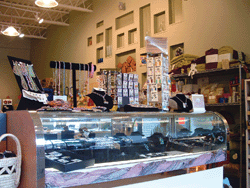 While some gift shops use the Web primarily as a branding and marketing tool, others use it as their only store. Simone Amerio, co-owner of Annabella Boutique (www.anabella-boutique.com), sells gift baskets and skin-care products exclusively through her website.
While some gift shops use the Web primarily as a branding and marketing tool, others use it as their only store. Simone Amerio, co-owner of Annabella Boutique (www.anabella-boutique.com), sells gift baskets and skin-care products exclusively through her website.
She says e-commerce allows her to run a business while having the ability to stay home with her two small children.
Having a corporate background and Web experience, Amerio built the entire website and maintains it herself. She says it is a very low-cost solution to build a business with minimal overhead and risk. For Amerio, business comes mostly through word-of-mouth.
Some online-only models have proved so successful that retailers do not find it necessary to make the leap to brick-and-mortar storefronts. Jennifer DeMaria is one. Through her website, www.jennyboston.com, DeMaria sells fashions and related accessories to customers all over. She leverages the power of the Web to host “e-parties,” a virtual version of home parties, whereby customers can invite friends to parties and together get bonuses and prizes. The concept has proved to be extremely popular and because of the broad audience the store commands, DeMaria is quite sure she won’t open a brick-and-mortar anytime soon.
Making the Web work
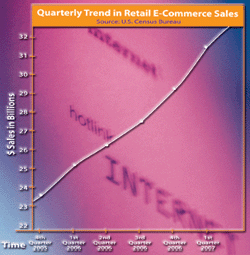 Like Amerio at Annabella Boutique, many small business owners opt to build their own websites. With some of today’s programs and Web-hosting solutions, it doesn’t take much more than basic computer skills to create a simple and functional website. Walters at OverCoffee Productions recommends that retailers stick to a template for a first website, and focus their time and money on email marketing and website maintenance. Pointing to the ease of upgrades, Walters says a website can always be fine-tuned later on.
Like Amerio at Annabella Boutique, many small business owners opt to build their own websites. With some of today’s programs and Web-hosting solutions, it doesn’t take much more than basic computer skills to create a simple and functional website. Walters at OverCoffee Productions recommends that retailers stick to a template for a first website, and focus their time and money on email marketing and website maintenance. Pointing to the ease of upgrades, Walters says a website can always be fine-tuned later on.
Directing visitors to a website, and collecting email addresses from orders and other means, offers a golden opportunity to begin email marketing. Chuck Bauer, co-owner of the The Soap Opera in Madison, WI, sends out periodic broadcasts via email to all customers on his list. Reminding customers about the store’s products, notifying them about sales and therefore “popping back” into the customers’ minds can produce immediate results. “We send five or six thousand emails once a week, and they always produce a spike in orders,” says Bauer. Email blasts are also much cheaper alternatives to postcard and catalog mailings. However, Walters cautions against abusing the system and bombarding customers with too much email. A privacy policy on retail websites, indicating exactly how the addresses received are going to be used, is also vital.
The Web affords other interesting sales and marketing opportunities. Homescapes in Carmel, CA, sells finds from across the world. Thompson Lange, Homescapes’ co-owner, maintains a blog that is part travelogue, part update about the store. It’s an efficient way to make visitors check back often and be a part of the store.
Worldwide competition
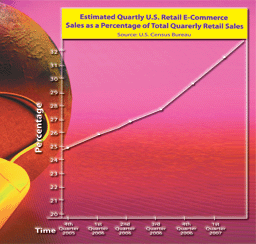 When it comes to the Internet, the potential customer base might be huge. But unfortunately, so is the competition. Rankings in online searches can often determine whether retailers make sales. Search-engine optimization, the process of making a website or a web page appear at the top of search lists, is critical in e-commerce. A website must be embedded with certain “meta tag” keywords that allow search engines to find the site. Ann Arbor, MI, Web designer Mary Cronin calls it an “art form,” and says retailers need to have the right keywords written in their web page header codes. She says that to really top searches, retailers should enlist the help of a professional, or opt for paid advertising on Google. “There’s only so much a Web designer can do. How pages get bumped up on the search listings is almost an art. Some retailers can really benefit from paying to get a top listing,” says Cronin. Tom Graefen says that paid advertising and promoting a site on Google, Overture and Yahoo guarantee that when a Web user enters the right phrase in the search engine, it will pull up Monarch’s Heaven.
When it comes to the Internet, the potential customer base might be huge. But unfortunately, so is the competition. Rankings in online searches can often determine whether retailers make sales. Search-engine optimization, the process of making a website or a web page appear at the top of search lists, is critical in e-commerce. A website must be embedded with certain “meta tag” keywords that allow search engines to find the site. Ann Arbor, MI, Web designer Mary Cronin calls it an “art form,” and says retailers need to have the right keywords written in their web page header codes. She says that to really top searches, retailers should enlist the help of a professional, or opt for paid advertising on Google. “There’s only so much a Web designer can do. How pages get bumped up on the search listings is almost an art. Some retailers can really benefit from paying to get a top listing,” says Cronin. Tom Graefen says that paid advertising and promoting a site on Google, Overture and Yahoo guarantee that when a Web user enters the right phrase in the search engine, it will pull up Monarch’s Heaven.
Great expectations, razor-thin margins
 Because big-name Web companies such as Amazon.com have set the bar so high, Walters says, e-commerce consumers are “some of the most irritable, demanding customers” that a retailer will ever see. “They have sky-high expectations, are accustomed to having instant notifications on their order statuses and rapid shipping. Most customers who experience anything less of spectacular service will leave with the impression that they have made a bad deal,” he says.
Because big-name Web companies such as Amazon.com have set the bar so high, Walters says, e-commerce consumers are “some of the most irritable, demanding customers” that a retailer will ever see. “They have sky-high expectations, are accustomed to having instant notifications on their order statuses and rapid shipping. Most customers who experience anything less of spectacular service will leave with the impression that they have made a bad deal,” he says.
For a gift shop involved in e-commerce, orders that come in via the Internet must be fulfilled as soon as possible. Graefen says orders that come in by 1 p.m. are always shipped the same day. The company has three part-time workers who handle the fulfillment process. Chuck Bauer, co-owner of the Soap Opera in Madison, WI, says the logistics of fulfilling orders is relatively straightforward. All employees of the store prepare, pack and ship orders in between serving customers—a process that Bauer says makes employees more productive and eliminates the need to hire a new person simply for fulfillment.
Many retailers report that profit margins are actually slimmer over the Web because of the high costs of shipping and packaging—much of which have to be eaten by the retailer in order to offer competitive prices. “The profit margins for Internet sales are a lot narrower. You have to do volume or you will not make it with an Internet business. You have to pay for hosting [to run a website on computer servers], and you’re eating about $10 per box on free shipping charges,” says Graefen. He offers free shipping for orders of more than $79.
“You would think that an online store doesn’t have that much overhead, but in the end, there’s a lot of stuff that eats up the margins. With a bricks-and-mortar store, your costs are fixed,” says Bua Semapakdi, co-owner of the Satinbox Company in Somerville, MA. She says shipping charges are a major concern, and with just a few vendors providing shipping services, retailers and customers are at the mercy of their fees. To simplify fees and make it easier on the customers, Satinbox offers a flat rate of $6.50 on all orders.
Inventory and other concerns
 Since Web traffic is so much more difficult to predict than the brick-and-mortar kind, inventory can be another concern for retailers increasing their e-commerce business. If there’s too much, a retailer will have overspent on merchandise; if there isn’t enough, the retailer may face the embarrassment of not being able to fulfill orders. In preparing to sell online, Chadran, from Dunia, will open the store’s online shopping cart to family, trusted friends and customers first, until the store gets the hang of online operations and learns to balance inventory.
Since Web traffic is so much more difficult to predict than the brick-and-mortar kind, inventory can be another concern for retailers increasing their e-commerce business. If there’s too much, a retailer will have overspent on merchandise; if there isn’t enough, the retailer may face the embarrassment of not being able to fulfill orders. In preparing to sell online, Chadran, from Dunia, will open the store’s online shopping cart to family, trusted friends and customers first, until the store gets the hang of online operations and learns to balance inventory.
Walters, from OverCoffee, reminds retailers that keeping a website updated is important. “One of the beauties of the Web is that it is easy to upgrade, but if the website is outdated, there’s immediately a big negative. People will wonder if the store is even in business anymore. It can really work against you,” says Walters. These updates take time. Whether they have a shopping-cart or brochure site, gift-shop managers and owners should have the ability to make instant changes to the website themselves, Walters says.
Bricks and mortar, a solid foundation. When Semapakdi, of Satinbox, launched the website in 2005, a storefront was out of the question. She and her husband were living in high-priced San Francisco at the time, but they bought a storefront operation last year, when they moved to the comparatively affordable real estate market in the greater Boston area. “We weren’t really looking, but we just happened to find a place that wasn’t too big and not too much of a risk to try having a storefront. We just wanted to put a face to our online store and have a place to display our products,” says Semapakdi.
Although their Internet business is booming, retailers like Graefen, of Monarch’s Heaven, say their storefronts still provide the bulk of their revenues. Graefen notes that many suppliers and distributors will not ship to retailers that do not have brick-and-mortar buildings. While many don’t mind moving products online, they still want showroom capabilities, where their products can be out in front of the public. David Martinez, sales director for Seda France candles and fragrances, says that storefronts are the company’s best avenue for selling its products. “Many of our Web-only customers can do well with our products because we’ve made a name for ourselves, but the small, boutique retail stores have made us what we are today. It’s their loyalty that has helped us grow,” says Martinez.
Chadran, from Dunia, says that while he plans on furthering business online, he always wanted a brick-and-mortar store to serve as a physical entity where Dunia could build a community and forge connections with like-minded people in the Maynard area. Chadran says a storefront is critical in adding a face and physical branding capabilities to Dunia’s mission for earth-friendly home and gift products and in eliminating the potential disconnect between the retailer and the seller in online transactions.
Not online yet
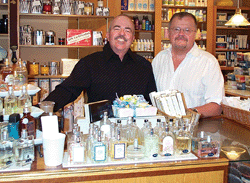 Having been in business for 36 years without a website, Susan Tanner of Yankee Peddler in Hinsdale, IL, is among the many retailers who don’t see maintaining a website as a necessary business strategy, especially considering the cost and expertise involved. Tanner says that the learning curve, cost and adjustments involved in putting her store online may actually take away from the business that she has learned and perfected over the past three decades. “I personally, and my customers, really need to see and touch things. I’ve tried to order things online, but have almost always had to send it back,” Tanner says.
Having been in business for 36 years without a website, Susan Tanner of Yankee Peddler in Hinsdale, IL, is among the many retailers who don’t see maintaining a website as a necessary business strategy, especially considering the cost and expertise involved. Tanner says that the learning curve, cost and adjustments involved in putting her store online may actually take away from the business that she has learned and perfected over the past three decades. “I personally, and my customers, really need to see and touch things. I’ve tried to order things online, but have almost always had to send it back,” Tanner says.
“I just think there would be too much involved, and by and large, we don’t have those resources. We’ve done well all these years without being online, so I really don’t see the need,” she says.
What the future holds
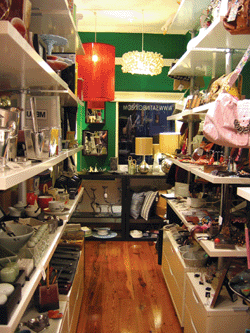 While the trends point to the Web as an increasing medium for retail commerce, don’t expect brick-and-mortar operations to disappear anytime soon. Most customers still have a need to see some things in person before they make a decision to buy.
While the trends point to the Web as an increasing medium for retail commerce, don’t expect brick-and-mortar operations to disappear anytime soon. Most customers still have a need to see some things in person before they make a decision to buy.
By all indications, though, we will see more retailers like Graefen, of Monarch’s Heaven, who are enjoying business through both their brick-and-mortar and online storefronts, with each driving business to the other. Monarch’s Heaven averages approximately 250 to 600 orders per month from the Web, with an average sale of about $100. That compares to an average sale in the store of about $30 to $50. Graefen went online about four years ago after he saw how much e-commerce was booming. He says the choice to go online was obvious, and he sees it as a critical step for any retail enterprise.
“You’ve just got to be able to change with the times. You can’t be sedentary in your ways. You need to follow the trends and have that ability to change,” he says.























